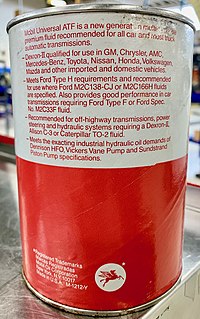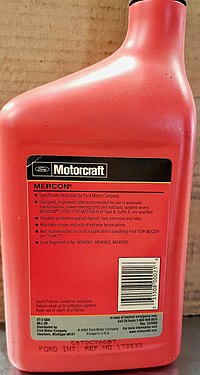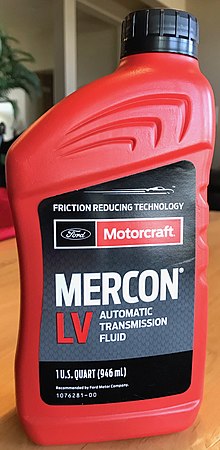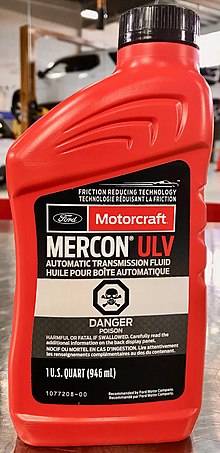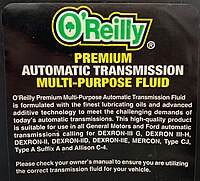Mercon
MERCON is the trade name of a series of technical specifications for automatic transmission oils that Ford has created. Ford had the name registered, first as a Registered Trade Mark and later as a trademark . Mercon may be licensed under Name and Specification to oil manufacturers who sell oils of that specification under their own brand names. Not all Mercon fluids are licensed for resale under another brand name. All licensed Mercon fluids must have a license number on the container. If a license number is not found, the fluid may not have been approved by Ford and there is no guarantee that the fluid will meet Ford specifications. Automobile manufacturers like Ford use transmissions that are supplied by transmission manufacturers around the world and not manufactured by Ford itself. Many of these automatic transmissions require special oils that may not be listed on this page.
Originally Ford only used its MERCON brand for automatic transmission oils , later also for other transmission oils and lubricants.
Ford automatic transmission fluids (ATF)
The original Mercon automatic transmission fluid specification (M2C185-A) is from January 1987. Over the years the original Mercon specification has been superseded by Mercon V, Mercon SP, Mercon LV and Mercon ULV. Ford has refined the Mercon specs over the years. The newer oils are not always backwards compatible with earlier oils. Newer 6- and 10-speed transmissions as well as transmission technologies of plug-in hybrids (PHEV) and electric vehicles (EV) require special oils in order to function properly. There is still a market for older oils that purport to meet the earlier oil specifications. Details on the backward compatibility of the individual oils are given in the following information:
Before the MERCON specification (1942–1987)
1942 - motor oil
In 1942, a "Liquamatic Drive", a three-speed transmission with a fluid coupling, a dry clutch for shifting and a vacuum-operated automatic gear change between second and third gear was offered for the Mercury 8 and Lincoln vehicles . The transmission had an overrunning clutch on the transmission shaft. At Lincoln the Liquamatic Drive was available with an additional overdrive .
The fluid coupling on the flywheel was filled with SAE 10 engine oil . The transmission ran in traditional transmission oil . This gearbox was made just a few months before the United States entered World War II. It didn't work, almost all of them were replaced by conventional gearboxes in recall campaigns and production of this gearbox was resumed after the war.
1949 - Fluid for GM Hydra-Matic
In April 1949, Lincoln began offering General Motors' Hydra-Matic 4-speed automatic in their 1950s models. This offer was continued in the 1954 model year. Lincoln's maintenance schedule called for "Lincoln Automatic Transmission Fluid". This fluid met the specifications of the GM Hydra-Matic drive fluid (see Dexron ).
This oil was first used in the following gearboxes:
- 1949 Hydra-Matic with L-9 prefix of the serial number
- 1950 Hydra-Matic with L-50 prefix of the serial number
- 1951 Hydra-Matic with L-51 prefix of the serial number
- 1952 Hydra-Matic with L-52 prefix of the serial number
- 1953 Hydra-Matic with L-53 prefix of the serial number
- 1954 Hydra-Matic with L-54 prefix of the serial number
1950 - GM type "A" fluid
It is important to understand that any automatic transmission made by any vehicle manufacturer ( Oldsmobile , Cadillac , Buick , Chevrolet , Pontiac , GMC , Ford, Mercury, Lincoln, Chrysler , Dodge , Desoto , Packard, and Studebaker ) will be GM transmissions built between 1949 and 1958 use type "A" oils.
In 1950, 11 years later, General Motors (GM) brought out the Hydra-Matic 4-speed automatic transmission and its special Hydra-Matic automatic transmission oil (see Dexron ). Ford offered its first fully automatic Fordomatic 3-speed transmission in 1951 . This new fully automatic transmission used GM type "A" oil. Ford and hundreds of other resellers became licensed resellers of the GM Type "A" oil with an OEM qualification number. The type "A" oil was sold under the brand name Ford.
This fluid was first used in the following gearboxes:
- 1951 Fordomatic (Borg-Warner FX) 3-speed automatic
- 1954 Criuseomatic (Borg-Warner MX) 3-speed automatic
- 1955 Lincoln TurboDrive 3-speed automatic
- 1957 Ford Transmatic Drive 6-speed automatic for medium-duty and heavy-duty trucks
- 1958 Cruise-O-Matic 3-speed automatic
- 1958 Edsel Mile-O-Matic 3-speed automatic
- 1958 Mercury Multi-Drive
- 1958 Lincoln TurboDrive 3-speed automatic
1959 - Ford "A" type fluid
In 1959, Ford published its own Type-A automatic transmission fluid specification (M2C33-A) and stopped adopting GM's oil specifications for its own transmissions. The Ford M2C33-A oil had the suffix "A" from the GM type "A". The life of the gear oil was quite short and frequent gear oil changes were required.
1959 - Type "B" fluid
In 1959, Ford published an updated specification for Type B automatic oil (M2C33-B). The Ford M2C33-B oil met the properties of the GM type "A" oil. As with the previous specification, the transmission fluid life was quite short and frequent transmission oil changes were required.
1960 - "D" type fluid
In 1960, Ford introduced the Type-D specification (M2C33-D) for the use of operating fluids in 1960 model year vehicles. This change in the oil specification also led to better oxidation behavior, better wear resistance and higher static capacities. The oxidation property of the oil was measured using a new Merc-O-Matic oxidation test.
This fluid was first used in the following gearboxes:
- 1964 C-4 3-speed automatic
- 1966 C-6 3-speed automatic
- 1968 FMX 3-speed automatic
1967 - "F" type liquid
In 1967 Ford introduced a new specification for fluids, the Type-F Fluid (M2C33-F). This fluid provided a high static coefficient of friction that resulted in rough shifting. The specification of type F oils should be a "lifetime" oil that never needs to be renewed. It was the first of many Ford lifetime oils. In the Ford workshop manual from 1974 it says: “The automatic transmission is filled with a 'lifetime medium' at the factory. If fluid needs to be topped up or replaced, fluids that conform to Ford specification M2C33F must be used. "
1972 - "G" type liquid
In 1972, Ford introduced a new oil specification in Europe, the Type-G fluid (M2C33-G). This oil was used until 1981.
This oil was first used in the following gearboxes:
- Borg-Warner 35 automatic transmission and its variants
1974 - "CJ" type liquid
In September 1974 Ford introduced the new specification for type CJ oils (M2C138-CJ). This oil ensured smoother shifting and less tooth noises due to higher dynamic friction properties. The Ford Type CJ oil specification also conformed to the GM Dexron -II (D) and previous specifications. Ford was a licensed manufacturer of GM Dexron-II (D).
This compatibility could mean all Ford Mercon oils are Dexron compatible, which is incorrect. The oil recommended by the manufacturer for the gear unit must always be used. (See below, Aftermarket Automatic Transmission Oils section )
This fluid was first used in the following gearboxes:
- 1974 C-3 3-speed automatic in the Pinto
- 1978 ATX 3-speed automatic
- 1980 ATX 3-speed automatic with centrifugally coupled clutch (CLC) in the torque converter
- 1980 Jatco 3-speed automatic
- 1980 ATX 3-speed automatic with a Fluid Linked Clutch (FLC) in the torque converter
- 1980 AOD 4-speed overdrive automatic with torque converter bypass (Ford's first fourth overdrive)
- 1983 ZF-4HP33 4-speed high-speed automatic (Dexron-II (D))
1981 - "H" type liquid
As a result of the OPEC oil embargo in 1973 and the shortage of fuel, the US government issued the Corporate Average Fuel Economy (CAFE) regulation in 1975. The regulations should be fully implemented by the 1978 model year. The automotive industry responded with three normally unused transmission technologies:
- A 4th gear ( overdrive )
- A hydrodynamic torque converter clutch (TCC)
- Front wheel drive (FWD).
The introduction of the TCC led to customer complaints about fluttering while driving. All vehicle manufacturers had made changes to their ATF specifications and the controls on their TCC to address the problem. GM published the Dexron II (D) specification in 1978, Chrysler the ATF + 2 specification in 1980, and Ford came up with the Type H specification (M2C166-H) in June 1981.
The Type H fluid specification enabled improved frictional properties in torque converter clutches (reduced vibration during application and release). With this new specification, Ford introduced the Aluminum Cup Oxidation Test (ABOT), which replaced the older Merc-O-Matic Oxidation Test.
The Ford Type H fluid was compatible with GM Dexron II (D) specifications. This compatibility may mean for some but not all fluids that Fords, Mercon and GM Dexron are compatible. The fluid recommended by the manufacturer for the gear unit must always be used. (See below, Aftermarket Automatic Transmission Oils section )
This fluid was first used in the following gearboxes:
- 1982 C-5 (C4 with torque converter clutch (TCC)) 3-speed automatic
- 1985 A4LD (C3 with overdrive) 4-speed automatic
- 1986 AXOD 4-speed automatic
- 1986 Electronic 4-speed automatic A4LD
MERCON liquids from 1987
1987 - MERCON
In January 1987, Ford released the original Mercon specification (M2C185-A). Mercon became a trademark for liquids by qualifying and licensing liquids to ensure quality in the marketplace. This original Mercon specification was backward compatible with the 1981 Ford Type H fluid and the 1958 GM Type "A".
Compatibility: This version of Mercon was compatible with GM's Dexron-II (D) and later formulations were compatible with Dexron-III (H). However, future versions of Mercon (Mercon V, Mercon SP, Mercon LV, Mercon ULV) are not compatible with GM's Dexron III (H) or a newer version of Dexron (Dexron-VI, Dexron HP, Dexron ULV).
This fluid was first used in the following gearboxes:
- 1989 E4OD (C-6 with overdrive) Ford's first electronic 4-speed automatic
- 1990 4EAT-G Mazda 4-speed automatic
- 1990 F-4EAT 4-speed automatic
- 1990 XOD-E 4-speed automatic
- 1992 AOD-E (Electronic AOD) 4-speed automatic
- 1993 AOD-EW / 4R70W 4-speed automatic
- 1994 AX4S 4-speed automatic
- 1994 CD4E Batavia 4-speed automatic
- 1995 AX4N / 4F50N 4-speed automatic
- 1995 4R44E 4-speed automatic
- 1995 4R55E 4-speed automatic
- 1997 5R44 (Ford's first 5-speed automatic transmission)
- 1997 5R55 5-speed automatic
1996 - MERCON V
In 1996, Ford released the Mercon "V" fluid specification (M2C202-B). Ford Technical Service Bulletin (TSB) 06-14-04 states that Mercon "V" is intended to replace the original Mercon fluid.
This fluid was first used in the following gearboxes:
- 1998 4R100 4-speed automatic
- 2000 4F27E 4-speed automatic
The Mercon specification "V" was revised in 2002 (M2C919-E). This revised fluid was first used in the following gearboxes:
- 2003 4R75E 4-speed automatic
- 2003 4R75W 4-speed automatic
- 2003 5R110W 5-speed automatic
2001 - MERCON SP
In August 2001, Ford released Mercon's “SP” specification (M2C919-D).
The Ford SSM 21114 of November 26, 2009 states that Mercon Replace “SP” is to be replaced by Mercon LV for Torqshift transmissions from model years 2003 to 2008. The SSM does not apply to the ZF 6HP26 transmission.
This fluid was first used in the following gearboxes:
- 2001 5R110W Torque Shift 5-speed automatic
- 2005–2008 ZF 6HP26 6-speed automatic of the Lincoln Navigator
2005 - MERCON LV
In December 2005, Ford published Mercon's "LV" specification (M2C938-A).
This fluid was first used in the following gearboxes:
- 2006 6R60 ZF 6-speed automatic
- 2006 FNR5 Mazda 5-speed automatic
This specification was revised in 2007 for the following transmissions:
- 2007 6F50 6-speed automatic
- 2007 6R80 6-speed automatic
- 2009 6F35 6-speed automatic
This specification was revised again in 2010 (M2C938-A2) and has been optimized for the suppression of friction noises (anti-squawk) in clutches. This revised fluid was first used in the following gearboxes:
- 2011 6R140 6-speed automatic
- 2013 HF-35 eCVT hybrid drive
2014 - MERCON ULV
The fluid specification for Mercon's ULV (Ultra-Low Viscosity) was issued on January 2, 2014. Mercon ULV is comprised of a Group 3+ base oil and additives necessary for proper operation of the 2017 Ford 10R80 and above and the GM-10L90 10-speed rear-wheel drive.
This transmission and transmission fluid specification were jointly developed by Ford and GM. The current specification that defines the fluid is FORD WSS-M2C949-A. This fluid is also sold as Dexron ULV.
Features: Mercon ULV's Quart Containers require shaking to stir ingredients before pouring. This fluid is not backwards compatible with older fluids.
This fluid was first used in the following gearboxes:
- 2017 10R80 10-speed automatic
- 2017 6F15 6-speed drive
- 2017 6R100 6-speed automatic
Ford "Lifetime" ATF
The 1967 Ford specification of the type F fluid was intended to define a "lifetime" oil, that is, an oil for life that never needs to be replaced. This was the first of many “Lifetime” oils from Ford. In the Ford Auto Service Manual from 1974 it says: “The automatic transmission comes from the factory with a 'lifetime fill'. When fluid needs topping up or replacement, only use fluids that meet Ford Specification M2C33F. ”Many other transmission manufacturers followed suit with their own“ Lifetime ”automatic transmission fluids.
How ATF can survive a "lifetime"
To understand how a liquid can hold a "life", a 1939 Chrysler study Fluid Drive Fluid is helpful. The November 1954 issue of Lubrication Magazine (published by The Texas Company, later known as Texaco) included a story entitled "Evolution of the Chrysler PowerFlite Automatic Transmission." This article describes the fluid used in the 1939 Chrysler Fluid Drive and its subsequent revisions and improvements through 1954.
A section of the feature describes the lubrication of the Fluid Drive's fluid coupling, it states, "The wet coupling is partially filled with Mopar Fluid Drive Fluid, a special highly refined pure mineral oil with a viscosity of about 185 SUS at 100 ° F [37.7 ° C]. , excellent inherent oxidation stability, high viscosity index (100), excellent ability to repel air quickly, very low natural pour point (-25 ° F [-31.6 ° C] ), ability to adequately lubricate the guide ball bearing and sealing surface, and neutrality compared to the sealing bellows.
The liquid works under almost ideal conditions in a substantially hermetically sealed housing. The initially present small amount of atmospheric oxygen is removed by a harmless reaction with the fluid to leave a residual inert (nitrogen) atmosphere. As a result, there was no need to drain and replace the fluid. The recommendation for checking the level was gradually expanded from the original 2,500 miles to 15,500 miles [4,000 to 25,000 km] and finally to 'never' - or the entire life of the car.
Since processes and level controls were not only unnecessary, but were also often harmful (by introducing more air and dirt by destroying the seal), Chrysler finally discontinued the seductive level test screws. This mechanism is therefore one of the few that is actually lubricated for the life of the car. There are now countless examples of clutches that have worked well over 100,000 miles [161 tkm] without paying any attention and were still in perfect condition when the car was taken out of service. ” The lesson learned from Chrysler's fluid drives also applies to modern automatic transmission.
Sealed gears
Any automatic transmission fluid would last longer if the transmission case could be hermetically sealed, but transmissions typically have two potential entry points for air:
- The dipstick tube
- Any transmission with a dipstick tube may admit additional oxygen into the transmission through a dipstick that is not fully seated in the tube or an incompletely seated dipstick tube plug. Even checking the fluid level with a dipstick can let extra oxygen and debris into the transmission. Many modern gearboxes do not have a dipstick, instead they have sealed gear plugs. By removing the traditional dipstick, the transmission manufacturer has also removed a potential entry point for oxygen. This reduces the risk of the oil oxidizing. A sealed transmission typically has a longer transmission oil life than an unsealed transmission.
- The transmission ventilation
- Gearboxes require ventilation openings to compensate for internal air pressure differences that occur with fluctuating fluid temperatures and fluid levels during gearbox operation. Without these openings, pressure could build up, leading to leaks and leaks. Prior to the use of an improved quality base oil in the late 1990s, some older transmission air vents included an overpressure vent or TABS (Transmission Air Breathing Suppressor) valve to prevent oxygen and water from entering the transmission. Oxygen reacts with high temperature transmission fluid and can cause oxidation, rust, and corrosion. Automatic transmission fluids with lower quality base oils oxidized more easily than fluids with higher quality base oils. Ford and other transmission manufacturers are now using smaller, remotely mounted vents that are specifically designed to remove water but allow a small amount of air through the vent when needed.
Sealed ATF containers
Any automatic transmission fluid will last longer if it comes from an unopened container.
- Use of sealed containers. Containers that hold automatic transmission fluid (ATF) should always be closed. When exposed to the atmosphere, ATF can absorb moisture and potentially create displacement concerns.
- Use only new liquid. When performing repairs on ATF equipped transmissions, it is important to use only new, clean ATF when refilling the transmission. Never use ATF again.
Example maintenance plan
| Ford ATF exchange interval under conditions of "Severe Driving" or "Extreme Driving" | ||||
|---|---|---|---|---|
| Fluid Specification | Miles | |||
| 1949 GM Hydra-Matic | 5,000 | |||
| 1950 GM Type "A" | 10,000 | |||
| 1959 type "A" | 15,000 | |||
| 1959 type "B" | 15,000 | |||
| 1960 type "D" | 15,000 | |||
| 1967 type "F" | 30,000 | |||
| 1972 type "G" | 30,000 | |||
| 1974 type "CJ" | 30,000 | |||
| 1981 type "H" | 30,000 | |||
| 1987 Mercon | 30,000 | |||
| 1996 Mercon V | 100,000 | |||
| 2001 Mercon-LV | 150,000 | |||
| 2014 Mercon ULV | 150,000 | |||
| * See vehicle maintenance manual for how the conditions for "Severe Driving" or "Extreme Driving" are defined and which maintenance interval is recommended. | ||||
| Ford ATF exchange interval under conditions of "Severe Driving" or "Extreme Driving" | ||||
|---|---|---|---|---|
| Fluid specification | Miles | |||
| 1949 GM Hydra-Matic | 2,500 | |||
| 1950 GM type "A" | 5,000 | |||
| 1959 type "A" | 7,500 | |||
| 1959 type "B" | 7,500 | |||
| 1960 type "D" | 7,500 | |||
| 1967 type "F" | 12,000 | |||
| 1972 type "G" | 12,000 | |||
| 1974 type "CJ" | 12,000 | |||
| 1981 type "H" | 12,000 | |||
| 1987 Mercon | 12,000 | |||
| 1996 Mercon V | 30,000 | |||
| 2001 Mercon-LV | 30,000 | |||
| 2014 Mercon ULV | 30,000 | |||
| * See vehicle maintenance manual for how the conditions for "Severe Driving" or "Extreme Driving" are defined and which maintenance interval is recommended. | ||||
Lifetime automatic transmission oils with higher quality base oil and additive package are more chemically stable, less reactive and do not oxidize as easily as lower quality fluids made from lower quality base oils and additives. Therefore, higher quality gear oils can reach 100,000 miles (160,000 km) or more under normal driving conditions.
The definition of “Lifetime Fluid” differs from gearbox manufacturer to gearbox manufacturer. The correct maintenance intervals for the transmission fluid and the definition of the operating conditions can always be found in the vehicle maintenance manual.
Example on the Ford F-150 BJ 2018: According to the plan for planned maintenance work on a 2018 Ford F-150 with "Lifetime Fluid", there can be three different maintenance intervals for the transmission oil, depending on the driving style of the vehicle:
1 Normal driving
- Normal commuting with highway driving
- No or poor loading or towing
- Flat to moderately hilly roads
- No longer idle
Replace automatic transmission fluid every 150,000 miles (240,000 km).
2. Heavy operation
- Medium to heavy load or towing
- Driving uphill or off-road driving off-road
- Extended idle time
- Long hot or cold operation
Change automatic transmission fluid every 30,000 miles (48,000 km).
3. Extreme driving
- Maximum possible load or towing
- Extremely hot or cold operation
Change automatic transmission fluid every 30,000 miles (48,000 km).
| Base oil categories for Ford ATF based on the oil available at the time and under normal driving conditions | ||||
|---|---|---|---|---|
| API base oil | miles | |||
| 1949 Group 1 | 5,000 | |||
| 1950 Group 1 | 10,000 | |||
| 1959 Group 1 | 15,000 | |||
| 1959 Group 1 | 15,000 | |||
| 1960 Group 1 | 15,000 | |||
| 1967 Group 1 * | 30,000 | |||
| 1972 Group 1 * | 30,000 | |||
| 1974 Group 1 * | 30,000 | |||
| 1981 Group 1 * | 30,000 | |||
| 1987 Group 1 * | 30,000 | |||
| 1996 Group 2+ | 100,000 | |||
| 2001 Group 3 | 150,000 | |||
| 2014 Group 3+ | 150,000 | |||
| * Hydrotreated Group 1 | ||||
Aftermarket automatic transmission fluids
For over 70 years, the oil aftermarket has been producing both approved and unlicensed formulations for automatic transmission fluids (ATF). Today, aftermarket oils claimed by their manufacturers to be compatible for use in General Motors automatic transmissions continue to be sold under the designations Dexron / Mercon, multi-purpose and multi-vehicle oils. Unapproved oil is usually cheaper. Ford does not regulate or recommend these oils for use in their transmissions.
Manufacturer approval
Oil compatibility details on the front of an ATF container are often inconsistent with the information on the oil compatibility or the recommendations on the rear sticker.
example 1
The front label: O'Reilly Premium Automatic Transmission's multi-purpose bottle claim the fluid is "Compatible for use in General Motors and Ford automatic transmissions"
The label on the back of the same bottle states: "This high quality product is suitable for use in all General Motors and Ford automatic transmissions with the type" A ", suffix" A ", Dexron -II (C), Dexron-II (D ), Dexron-II (E), Dexron-III (G), Dexron-III (H), Type-CJ, and Mercon (Mercon 9187). On the back, you can check your owner's manual to make sure you get the Use the correct transmission oil for your vehicle. "
Meaning: This means that the fluid is only recommended for vehicles that require the original Mercon fluid from 1987. This also means that it is not recommended for other Ford vehicles that require Mercon V, Mercon SP, Mercon, LV, or Mercon ULV.
Example 2
The front label: Mobil 1 Synthetic's ATF multi-vehicle formula bottle claim the fluid is for "Ford, GM, and a variety of domestic and imported vehicles".
The back label: The same bottle claims ExxonMobil fluid is recommended for use in applications requiring 1987 Ford Mercon fluid as well as GM Dexron (B), Dexron-II (C), Dexron-II (D ), Dexron-III (G), Dexron-III (H) and other non-Ford applications. The back has an asterisk to indicate that the fluid is incompatible with Mercon LV or Mercon SP.
Meaning: This fluid is only recommended for vehicles that require the original 1987 Mercon fluid. This also means that it is not recommended for other Ford vehicles that require Mercon V, Mercon SP, Mercon, LV, or Mercon ULV.
See also
- DEXRON - automatic transmission oils for GM
- Mopar automatic transmission fluids for Chrysler
- Automatic transmission fluids for Toyota
- Automatic transmission oils
Web links
- Motorcraft Chemicals and Lubricants Catalog
- A Look at Changes in Automatic Transmission Fluid
- The History of Automatic Transmission Fluid - ATF History Part 1 [1]
- 69 Years of Ford Automatic Transmission Fluid - ATF History Part 3
- Changing Gears: The Development of the Automotive Transmission
- Ford Service Information Subscription Access
Individual evidence
- ↑ https://macsmotorcitygarage.com/automatic-failure-fords-1942-liquamatic-experiment/ Automatic Failure: Ford's 1942 Liquamatic Experiment
- ↑ https://www.sae.org/publications/technical-papers/content/500194/ FORD-MERCURY AUTOMATIC TRANSMISSION
- ↑ Type F Automatic Transmission Fluid and Power Steering Fluid .
- ↑ Richard Michell: Which Oil ?: Choosing the right oils & greases for your veteran, brass era, vintage, antique, classic or collector car October 15, 2011, ISBN 9781845843656 .
- ↑ MERCON V Automatic Transmission and Power Steering Fluid .
- ↑ https://www.aftermarketnews.com/ford-announces-new-replacement-specs-for-mercon-atf/ Ford Announces New Replacement Specs for Mercon ATF
- ↑ MERCON SP Automatic Transmission Fluid .
- ↑ MERCON LV Automatic Transmission Fluid .
- ↑ https://www.youtube.com/watch?v=hHU5xFOBcsU Ford Hybrid Transaxle Generations
- ↑ MERCON ULV Automatic Transmission Fluid .
- ^ Evolution of the Chrysler PowerFlite Automatic Transmission . In: Lubrication . tape 40 , no. 11 . The Texas Company, New York, NY November 1954, pp. 129-135 .
- ↑ https://patents.google.com/patent/US5129422A/en?oq=US5129422 Transmission breather control valve
- ↑ https://www.sae.org/publications/technical-papers/content/740055/ Transmission Air Breathing Suppressor (TABS) Valve - A Device for Improving Automatic Transmission Fluid Life
- ↑ https://patents.google.com/patent/US20110173935A1/en?oq=US20110173935A1 Transmission breather assembly
- ↑ https://owner.ford.com/tools/account/how-tos/owner-manuals-search-results.html?type=ymm&year=2018&make=Ford&model=F-150 Owner Manuals & Warranties










